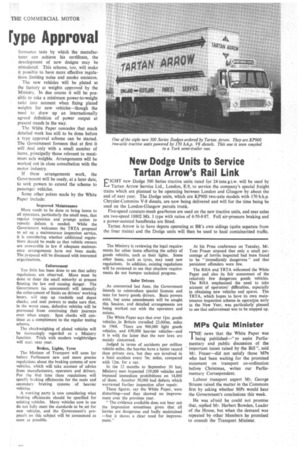rype Approval
Page 13

If you've noticed an error in this article please click here to report it so we can fix it.
formance tests by which the manufacturer can achieve his certificate, the development of new designs may be stimulated. This scheme, too, will make it possible to have more effective regulations limiting noise and smoke emission.
The new vehicles will be plated at the factory at weights approved by the Ministry. In due course it will be possible to take a minimum power-to-weight ratio into account when fixing plated weights for new vehicles—though the need to draw up an internationally agreed definition of power output at present stands in the way.
The Whit 6 Paper concedes that much detailed work has still to be done before a type approval scheme can be started. The Government foresees that at first it will deal only with a small number of items, principally those relevant to maximum safe weights. Arrangements will be worked out in close consultation with the motor industry.
If these arrangements work, the Government will be ready, at a later date, to seek powers to extend the scheme to passenger vehicles.
Some other points made by the White Paper include:
Improved Maintenance
More needs to be done to bring home to all operators, particularly the small men, that regular inspection and prompt action to remedy defects is needed. While the Government welcomes the TRTA proposal to set up a maintenance inspection service, it is considering whether additional regulations should be made so that vehicle owners are answerable in law if adequate maintenance arrangements have not been made. The proposal will be discussed with interested organizations.
Enforcement Too little has been done to see that safety regulations are observed. More must be done to deter the small minority at present flouting the law and causing danger. The Government (as announced) will intensify the enforcement of limits on drivers' working hours, will step up roadside and depot checks, and seek powers to make sure that, in the worst cases, defective vehicles will be prevented from continuing their journeys even when empty. Spot checks will continue as a complement to the regular testing scheme.
The checkweighing of plated vehicles will be increasingly regarded as a Ministry function. Trials with modern weighbridges will start next year.
Brakes, Lights, Tyres
The Minister of Transport will soon lay before Parliament new and more precise regulations about the braking systems of new vehicles, which will take account of advice from manufacturers, operators and drivers. For the first time these regulations will specify braking efficiencies for the main and secondary braking systems of heavier vehicles, A working party is now considering what braking efficiencies should be specified for existing vehicles. Many vehicles now in use do not fully meet the standards to be set for new vehicles, and the Government's proposals on this subject will be announced as soon as possible.












































































